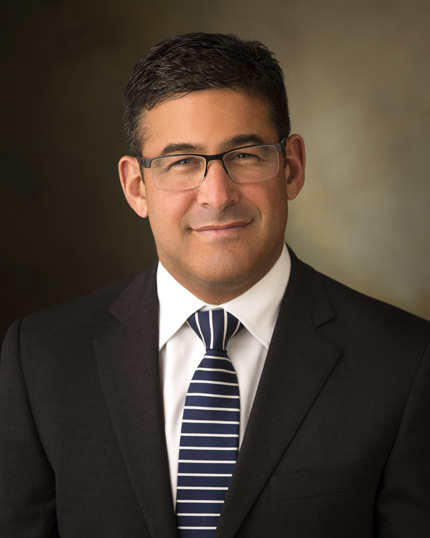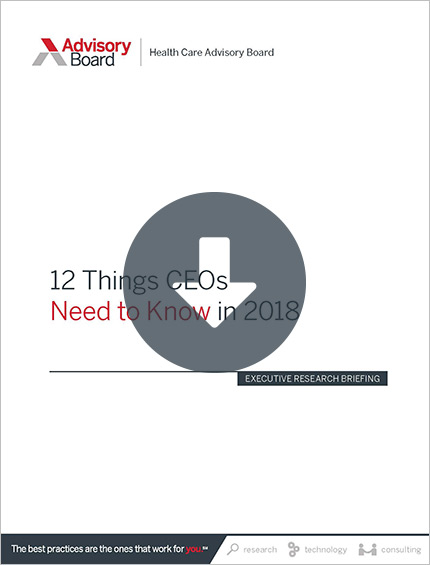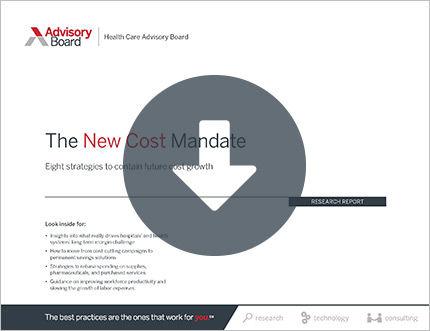Welcome to the "Lessons from the C-suite" series, featuring Managing Partner Eric Larsen's conversations with the most influential leaders in health care.
In this edition, Marc Harrison, president and CEO of Intermountain Healthcare, talks with Eric and Robert Musslewhite, Advisory Board Company's Chairman and CEO, about Intermountain's recently announced strategic reorganization, previews the launch of a "virtual hospital" to better serve rural communities, and shares the surprising worry that keeps him up at night. The conversation took place in December.

Marc Harrison, president and CEO, Intermountain Healthcare
The impetus for change
Question: Marc, in our last conversation, you told me about a presentation you gave shortly after you became CEO at Intermountain. You projected two images onto a screen: a horseless carriage from 1905, and a brand-new Tesla. And you said, "See that horseless carriage? That's who we are right now. And you see that Tesla? That's who we're going to be in the future."
And sure enough, here we are less than a year later and you've launched a huge reorganization. We'll get into the details of the shift in a moment, but first: Why take the leap? And why now?
Marc Harrison: We believe the health care landscape is changing massively and irrevocably right now. We're seeing changes in how care is delivered and paid for. Consumers are asking really hard questions—perhaps most of all in Utah, because although we're one of the states with the lowest per-capita health costs, we're among the top in out-of-pocket costs because of the proliferation of high-deductible plans.
So we're hearing regular people asking really hard economic questions. Even one of my own physicians, after a shift I helped on, asked if I knew how much I'd charged him for the plastic boot he needed after his foot surgery. I said, "Of course not." He said, "Well, you charged me $230. Do you know how much I could have gotten that for on Amazon, the very same boot?" "No." "Thirty bucks." He wasn't aggressive. He wasn't angry. He just wanted me to know.
We've seen this transformation in consumer attitudes, this transformation in how care is paid for—but quite frankly, hospitals and health systems haven't changed much. Almost every other industry is ahead of health care in terms of how it has organized itself, made itself more nimble, and used technology to make things better for consumers. I can't think of anybody else who's such a laggard: telecom, banking, retailing, hotels and hospitality, travel, manufacturing, anybody.
Q: Maybe agriculture? But even they are now using 'precision farming,' drone tractors, telemetry-based tech. Now that I think of it, we can't beat up on that industry any more.
Harrison: Exactly. And that gives us a perfect opportunity to make a pivot. Intermountain is a model health system now, but we know we're not going to be a model five years from now unless we innovate. We want to pivot when we're still clinically strong, we're economically strong, and we're culturally strong. We have to get ready for what the future looks like, and we think that's consumer-centric, we think it's digitally-enabled, and we think it's highly integrated, which is our target model.
So we have three key goals. One is to be as internally nimble as possible. Intermountain previously shifted from a confederation of hospitals to a confederation of regions. Now, we want to be a single enterprise.
Second, we need to do a better job of disseminating best practices. As innovative as we've been around developing best practices—and I think we're about as good as anybody in the United States—we still aren't doing enough. We strongly believe that regardless of where you are in our enterprise, you've got to get the same safety, quality of patient experience, and cost.
And then the third is that we just need to make care more affordable for everyone, regardless of their income or insurance coverage.
Inside Intermountain's transformation
Q: So let's talk about how you're trying to get there. You've shifted from a geographic operating structure—a central, north, south, and southwest region—to a model with two primary areas of focus that really correspond to how people most often access care. They are the Community Care Group, focused on preventive and primary care services, and the Specialty Care Group, focused on inpatient and specialty care. You're also expanding Intermountain's Clinical Programs to establish best practices across the system.
Those are big, consequential changes, and I suspect one of the difficulties is—given Intermountain is doing so well—it's hard to create urgency for change. I've heard you say, "I can wait for an Iora Health to come to my market and disrupt me, or I can from a position of strength self-disrupt." But culturally, how do you bring 39,000 caregivers along for that ride?
Harrison: We're just at the beginning of that journey, but as we start operating this way I think both our caregivers and our patients will experience a positive difference. Our management operating system, which has been extremely effective, calls for daily huddles at 10 a.m. We roll the entire system up to the C-suite on safety, quality, and patient experience. And we've kept that practice in the post-regional, transformed world. I think that's starting to reinforce that our values are still the same, our lines of communication are open, and so on.
The good news is that for most of our caregivers, life won't change at all. It only gets better. We continue to invest in their clinical enterprise. We make sure that their staffing is adequate. But there's still fear and uncertainty, because people always wonder what change means for them. So we're going to have to continue to work at communicating the why and the how and the what.
But none of this is new to our culture. Intermountain has a history of making really bold, innovative moves—like starting SelectHealth 30-plus years ago. When I talk to people who were at Intermountain at the time, they tell me they were incredulous: "Why are we getting into the insurance business? We're losing tons of money. How does this make any sense at all?" But I'm really lucky they took that leap, because now I've inherited a health plan that really works, that has more than 30 years of experience and takes great care of members and patients.
Q: That's an interesting point, Marc, because you and I have talked at length about how Intermountain has economic levers that other systems lack. You already have more than 850,000 lives under some degree of delegated risk, and 300,000 lives that are under full capitation—maybe even more now.
How do you think about the strategic shift you're making given that you've got this degree of vertical integration? You've got SelectHealth. You've got a significant percentage of revenue under full delegated risk.
Harrison: You know, Eric, I'm probably the CEO who talks the least about money, right? I think we have enough capitated volume that we can make these decisions and do the right thing. For me, it's really about how do we organize to deliver the optimal care to member/patients.
To do that, we have to recognize that we're really in three businesses right now. There's our specialty care business, which is largely episodic, serves our very sickest patients, and is very resource-intensive. This care occurs mostly in hospitals and then close to hospitals. In that business, we need to increase the alignment between doctors and hospitals. So now, with the reorganization, every physician that we employ reports up through the medical group. Historically, some of the specialty docs and surgical docs reported to the hospitals, creating unnecessary tensions and internal competition. That was unintentional, but it could be disconcerting, and it wasn't always great for patient care. So that's gone away.
Beyond specialty care, there's community care, and within that, there are two basic businesses. One is the traditional primary care business. Arguably, we do this as well any big system in the United States—but it's an area that's still relatively fee-for-service driven and episodic. And then there's the capitated or population health-based business. For both of those, we need an increasing focus on per-member per-month spending, plus an emphasis on safety, quality, and experience.
Q: Let's talk about the specific challenges of launching this kind of transformation in the state of Utah. Some of your patients live in very rural, inaccessible areas that are difficult for traditional providers to serve. How do you make sure the benefits of these changes reach all of your patients?
Harrison: Well, on January 1, 2018, our virtual hospital went live, and we're going to be able to deliver tertiary and quaternary services in our very small places. So that allows patients to stay in the least restrictive environment.
Let me give you an example. Somebody with a complicated infection historically would have needed to transfer to one of our major facilities. Now, though, all antibiotic stewardship for our entire organization is done virtually. Period. One team across the whole place. That allows people to get consults right in their community, in a small hospital—which, by the way, keeps those little hospitals viable.
We'll also need to innovate around how population-based primary care is delivered. In addition to the traditional primary care practices, we're going to need more defined-population practices that will help keep people out of the hospital and in really good shape.
Closing thoughts
Q: Let's wrap up by looking to the future. This is a seismic change for Intermountain, and I'm sure you are contingency planning and making constant adjustments to get this right. What, if anything, do you worry about as you move forward? What keeps you up at night?
Harrison: It's funny: We've talked about how quickly Intermountain is changing, but my big worry is that the industry isn't changing fast enough. If we don't, we'll wind up with a few big institutions with incredibly ill patients, very complex care, and no way to defray the cost structure for taking care of them. And then patients suffer, because in that kind of scenario, who does the innovation? Who keeps the pipeline full of wonderful new therapies? Who trains our next generation of clinicians?
There's also the risk of new companies disrupting us—and there are a million disruptors out there, whether it's in imaging or in spine care or in dentistry. Who's entering the market? It's folks from the tech industry who've got big ideas, moderate ability to execute, and lots of money. And they're able to say, "OK, starting from scratch, how would I build this?" That's a very different question than my peers are asking, which is, "How do I rationalize my extremely expensive and clunky cost structure?"
So these are big challenges, but I'm a super-optimist. I really am. I'm excited about where we're going and what we're doing. I think it's going to be really successful, and I think it's going to be great for patients and great for our communities.
Get more lessons from the C-suite
Check out Eric's recent must-read interviews with top hospital and health system leaders:
 Duke Health CEO's advice for young leaders: Take more risks
Duke Health CEO's advice for young leaders: Take more risks
Dr. Eugene Washington, Chancellor for Health Affairs at Duke University and President and CEO of Duke University Health System, talks about why he sees population health improvement as the system's "ultimate goal," his thoughts on the future of AMCs, and his phone-free approach to unwinding. Read our interview with Eugene.
 Can two CEOs co-lead? Bob Garrett and John Lloyd are showing how it's done.
Can two CEOs co-lead? Bob Garrett and John Lloyd are showing how it's done.
Bob Garrett and John Lloyd, co-CEOs of Hackensack Meridian, talk about their unique leadership structure, building a medical school for tomorrow's doctors, and what will headline Hackensack Meridian's press releases for 2022. Read our interview with Bob and John.
Don't miss out on the latest Advisory Board insights
Create your free account to access 2 resources each month, including the latest research and webinars.
Want access without creating an account?
You have 2 free members-only resources remaining this month remaining this month.
1 free members-only resources remaining this month
1 free members-only resources remaining this month
You've reached your limit of free monthly insights
Become a member to access all of Advisory Board's resources, events, and experts
Never miss out on the latest innovative health care content tailored to you.
Benefits include:
You've reached your limit of free monthly insights



